Before exploring the London Telephone Box, an update on the walk exploring Islington’s place in the history of London’s water supply and some of the original buildings at New River Head, that I wrote about in a post a couple of week’s ago. I will be guiding on some of these walks and whilst most of walks have now sold out, the only walk that has tickets remaining is on Friday 10th September (PM). They can be booked here.
I cannot remember the last time I used a telephone box, or when I last saw anyone else using one. The mobile phone has effectively killed off the need to find a telephone box, yet they are still to be found across the city.
I have a number of photographic themes when walking London’s streets and for the last couple of years, London’s telephone boxes has been added to my theme list. So long a key part of the city’s street infrastructure, I wonder for how long they will survive.
The majority do not work, many have had their phone equipment removed, and many are not in a state that you would wish to stand in and make a call, even if they did work.
Some have found new uses. The most common being advertising as they are often in prime street locations, with full length advertising covering their windows.
The original red telephone box was designed by Sir Giles Gilbert Scott, a design he entered into a Post Office competition in 1924. The model K2 telephone box was the result, which first appeared on the streets of London in 1926. He would then update the design to the K6 which first appeared in 1934 and is the traditional red telephone box we see across the streets of the city.
There have been many modifications, and significant redesigns, the majority of these coming after the Post Office / British Telecom was privatised in the 1980s.
The technology in the phone box has changed over the years. I can just remember the manual method of paying for a call when you had to Press Button A to put coins into the phone to make a call, then if the call was not answered, Press Button B to return the coins.
Having the right change for a phone call was always a problem, and hearing the dreaded pips when the money was running out and you had no more change was a challenge for calls of more than a few minutes.
There are some 2,390 telephone boxes which have been listed by Historic England. The majority are Grade II, but some Grade II*. Historic England have a spreadsheet available for download here, which details the location of all listed telephone boxes.
I have to admit to finding telephone boxes rather scary. I know exactly why. As a young teenager I watched the short 1972 Spanish horror film La Cabina, or the telephone box on TV. It is why whenever I used a telephone box I would always keep my foot in the door, to keep it slightly open. The film is on Reddit, here.
So, still never letting a door shut me in a phone box, here are a selection of photos of London telephone boxes, starting with Charterhouse Square:
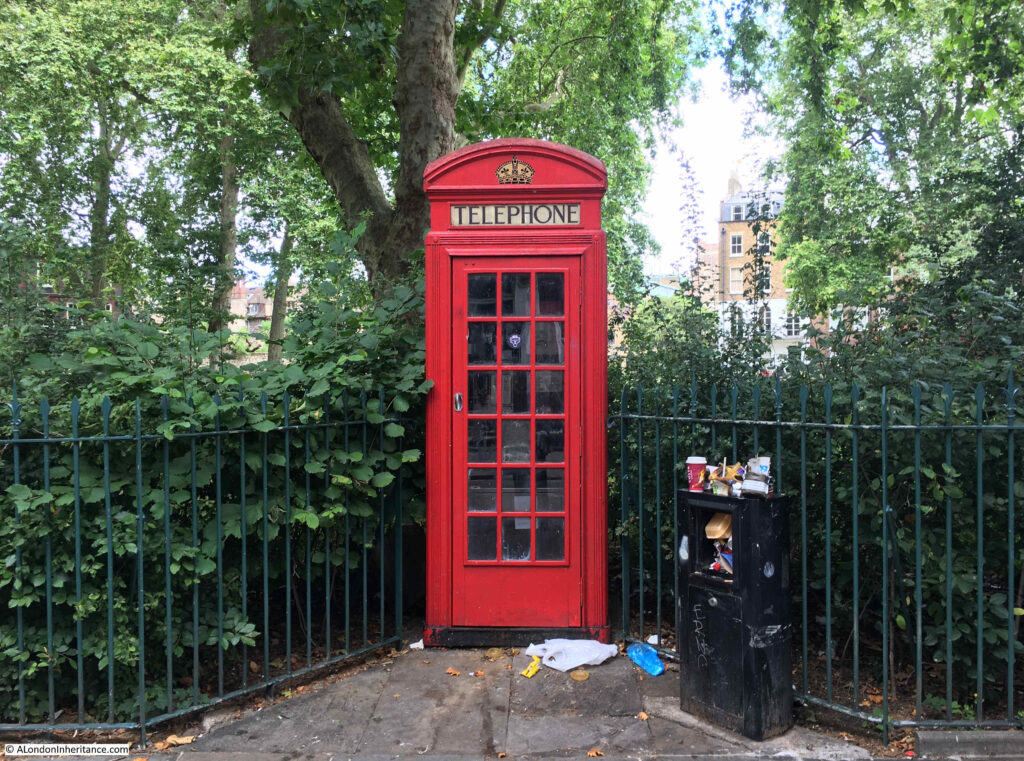
Grade II listed (the larger K6 models) telephone boxes at Smithfield Market:

One of the modern versions of the telephone box, also showing how so many of these are now used for advertising. This one is in Aldersgate Street:
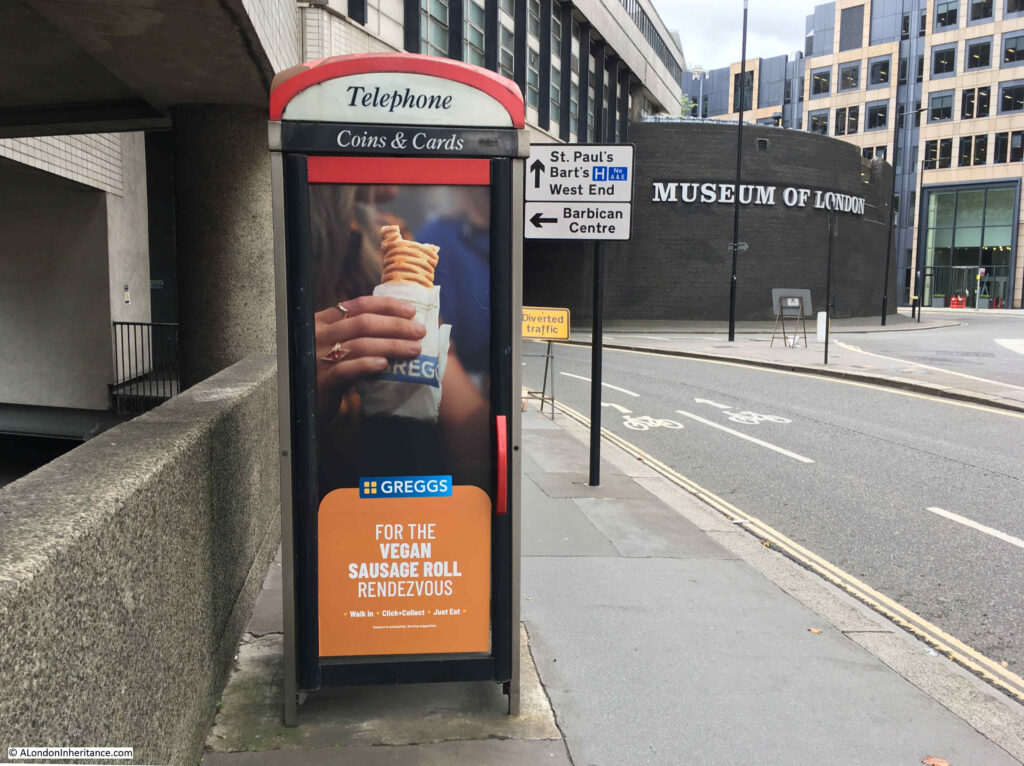
Advertising is a potentially profitable business for the reuse of telephone boxes. They are in locations where they are easy to be seen, and where there is a high footfall, so they originally could be found when you wanted to make a call. These original reasons for locating a phone box also apply to sites where advertising works best, and as advertised on the phone box in the photo below, at the junction of London Wall and Moorgate, there is a company (Redphonebox Advertising) that specialises in this new use.
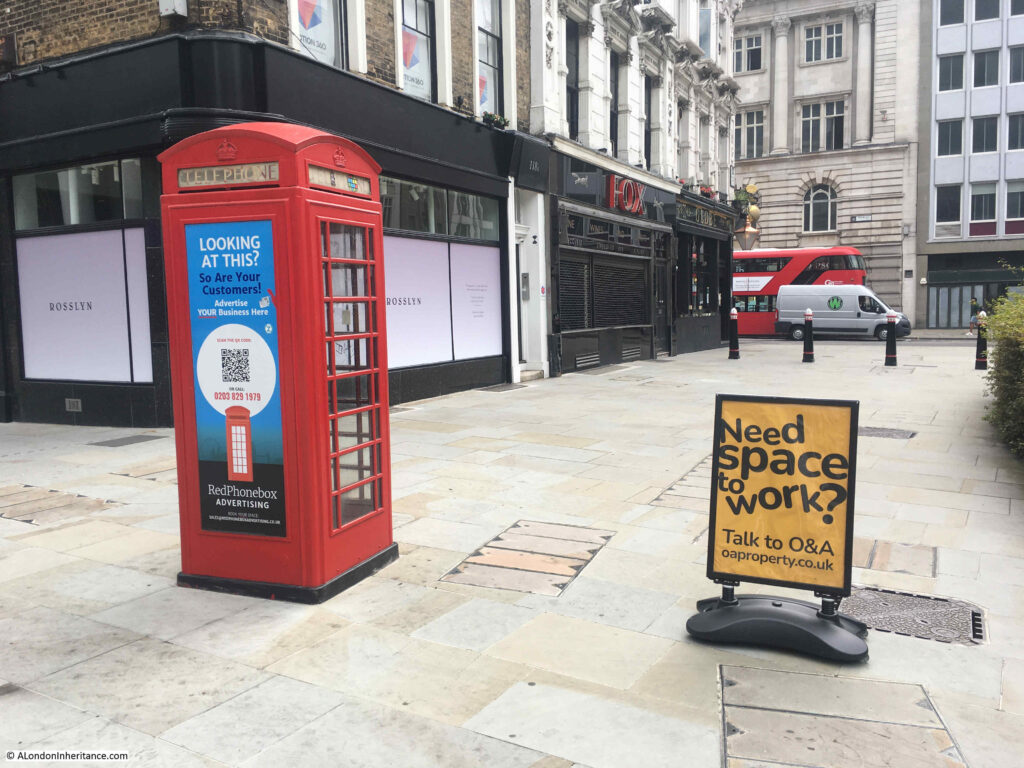
Perhaps the most photographed telephone box in London is this one in Great George Street / Parliament Square:
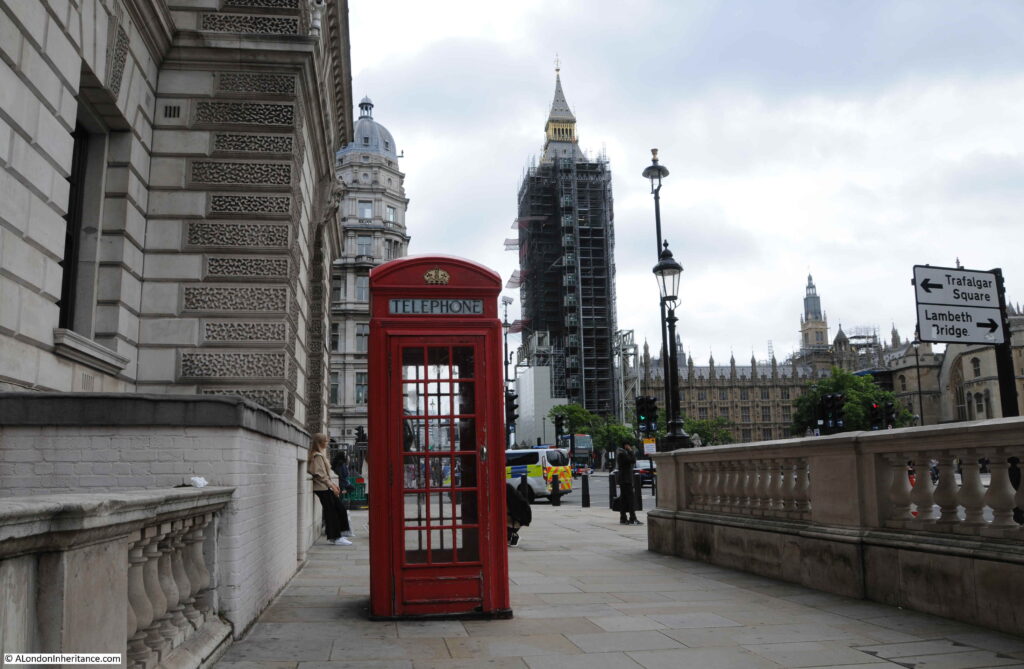
Before Covid, there would frequently be queues of tourists waiting to get their photo taken in a London red phone box with the Elizabeth Tower, or more probably Big Ben to those taking photos, in the background.
With the lack of tourists this phone box is now much quieter, and looking inside, even in such a prominent position, the telephone does not work, with the front panel being pulled away from the rear.
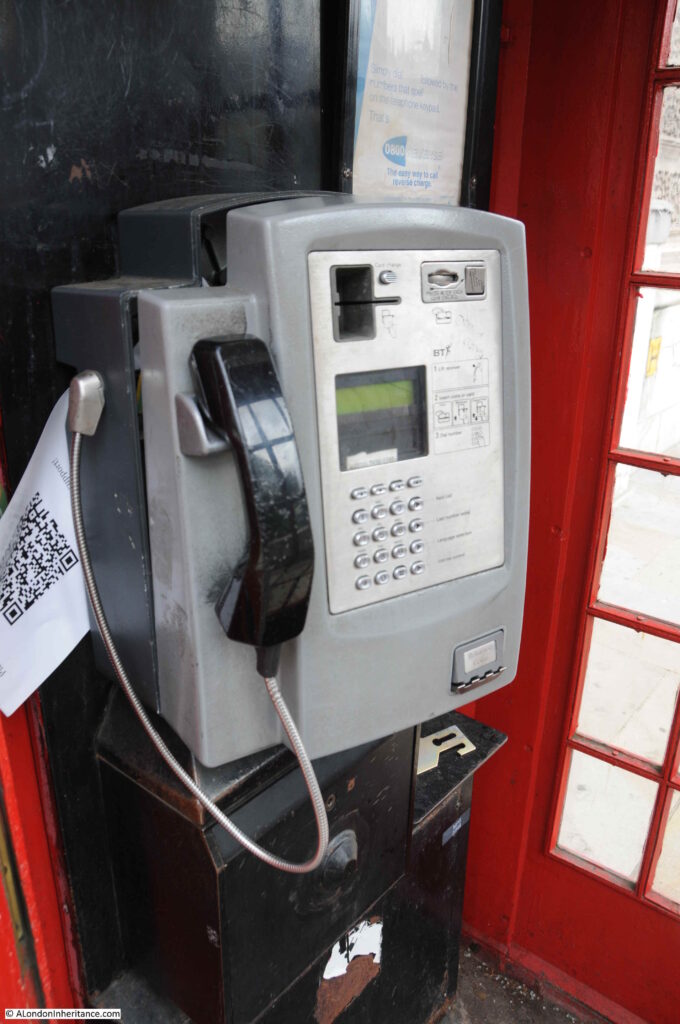
The following telephone boxes in Parliament Street are also a frequent destination for those wanting a photo with a phone box.

The following phone box is by the side of Grosvenor Road:

Internally, whilst the phone still has power, and the display reads BT Payphones, there is no chance of talking to anyone with the vandalised handset:
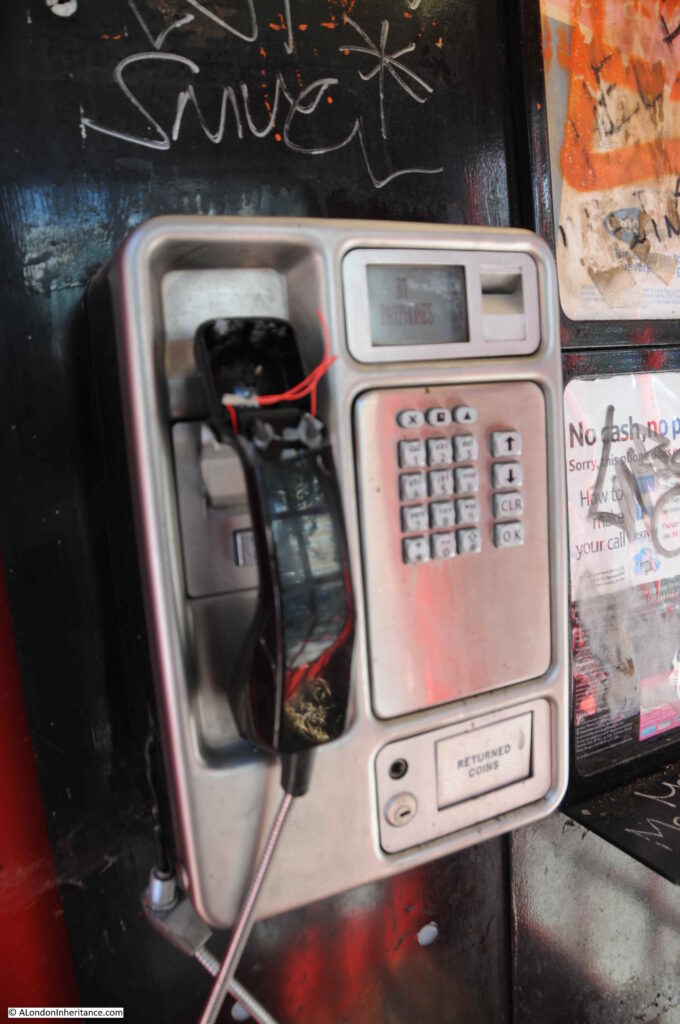
This view of the telephone box shows changing street furniture. The old, unused telephone box alongside a TfL cycle dock:
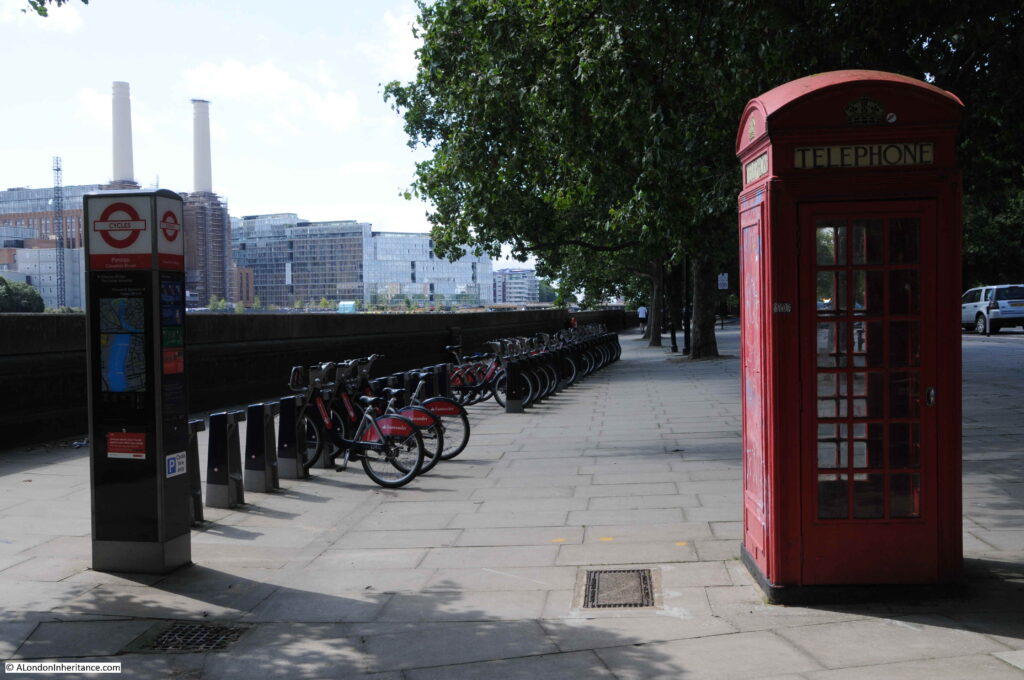
The above telephone box was made by Walter Macfarlane & Co, at their Saracen Foundry in Glasgow. It seems the company took on the manufacture of phone boxes in the late 1940s after their traditional markets started to disappear. The foundry closed, and the site demolished in 1967, however the company has left their mark on multiple telephone boxes across London:
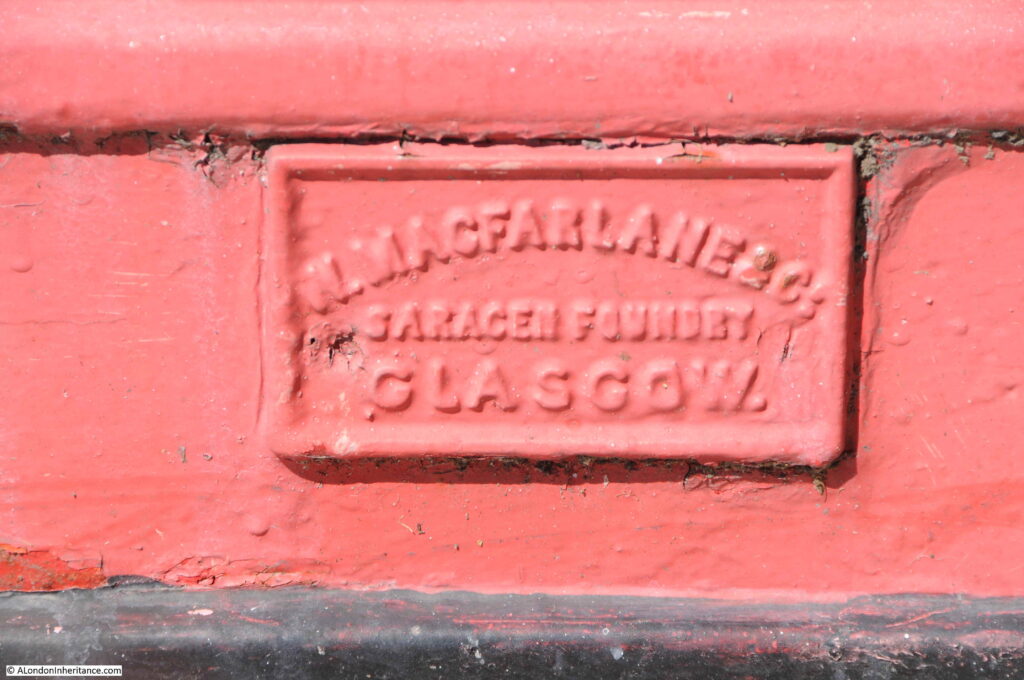
Outside Pimlico Station:

Duncannon Street, looking towards Trafalgar Square and the National Gallery:

St Martins Lane, opposite the Duke of York’s theatre:
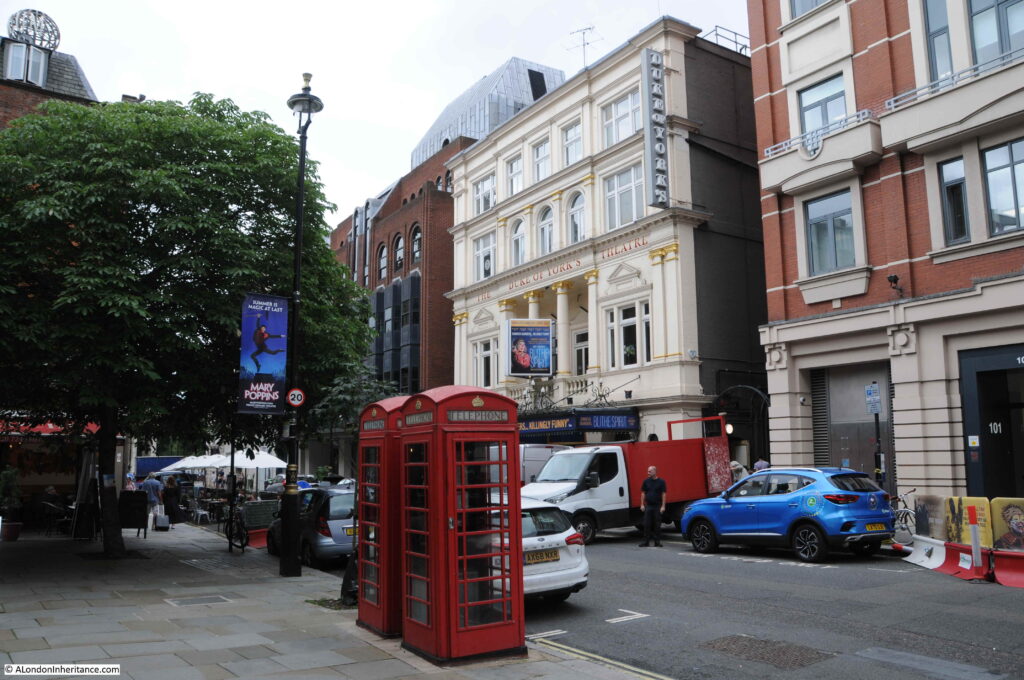
Great Newport Street:

The large blue plaque in the above photo records that the artist Joshua Reynolds lived there between 1753 and 1761.
Charing Cross Road, looking up towards the junction with Shaftsbury Avenue:
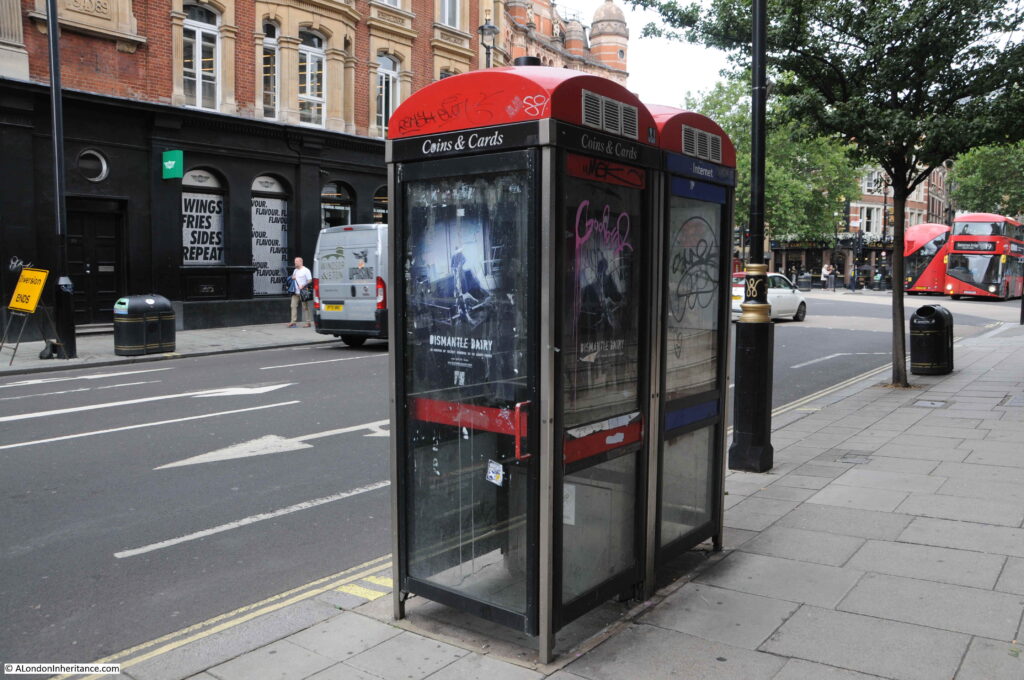
The telephone box in the following photo is in St Giles High Street with the church of St Giles in the Fields in the background. The door was left open, and at the time, it was not a phone box you would want to make a call from, even if it was working.
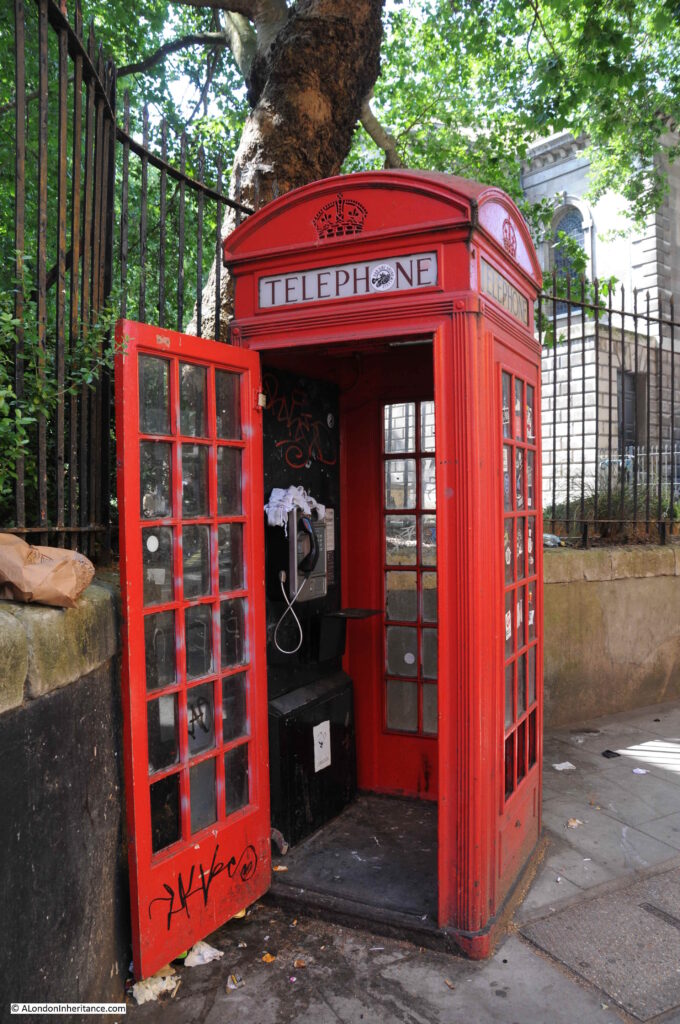
Shaftesbury Avenue:
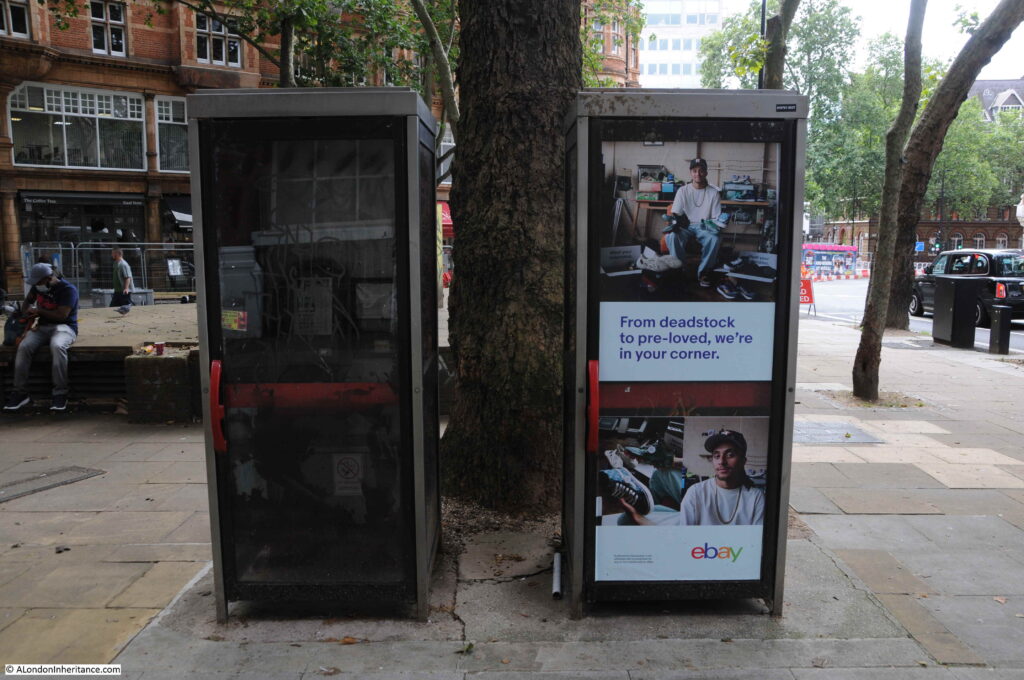
Bloomsbury Street, opposite the Bloomsbury Street Hotel:
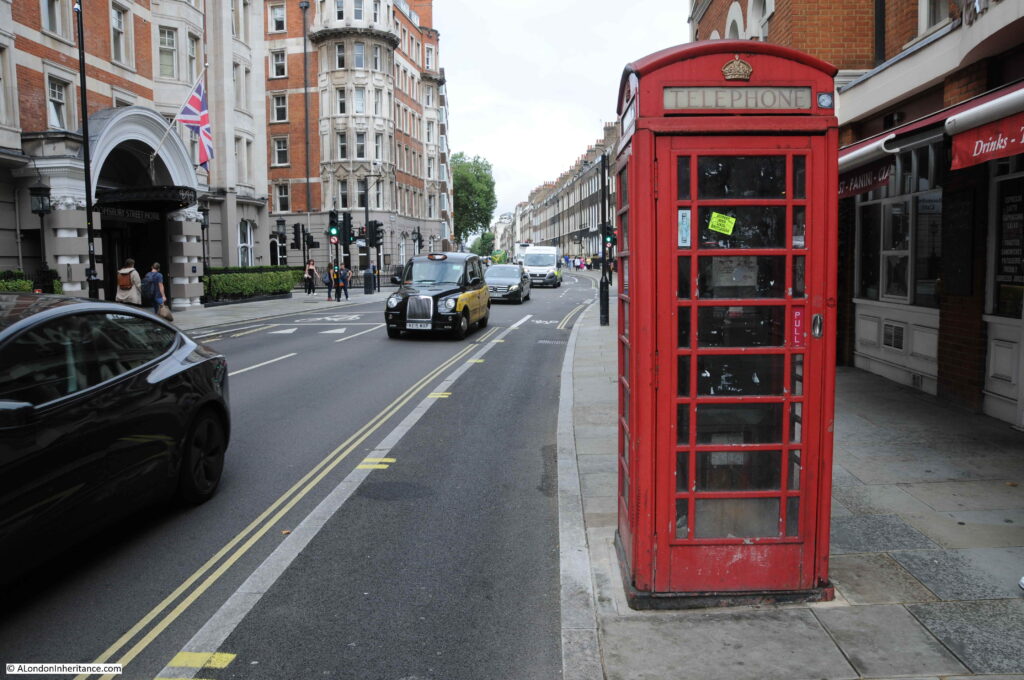
As with many telephone boxes across London, despite being in Bloomsbury Street, the phone box is used as a litter bin. The telephone equipment has been removed.

Outside the British Museum:
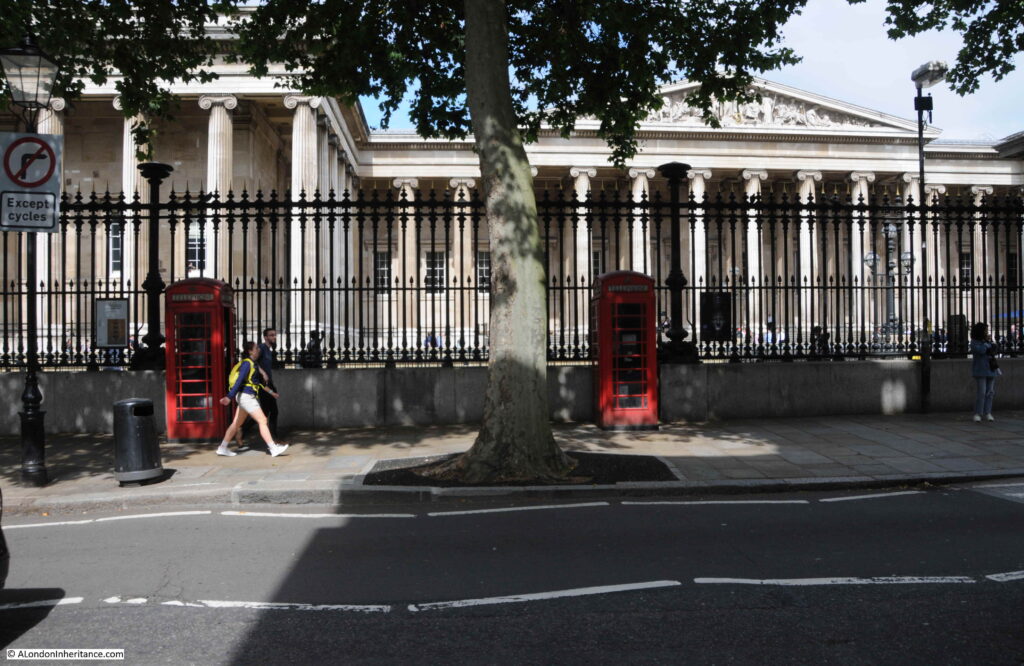
Telephone boxes have been converted to other uses. In Russell Square, two have been converted to a take away coffee shop:
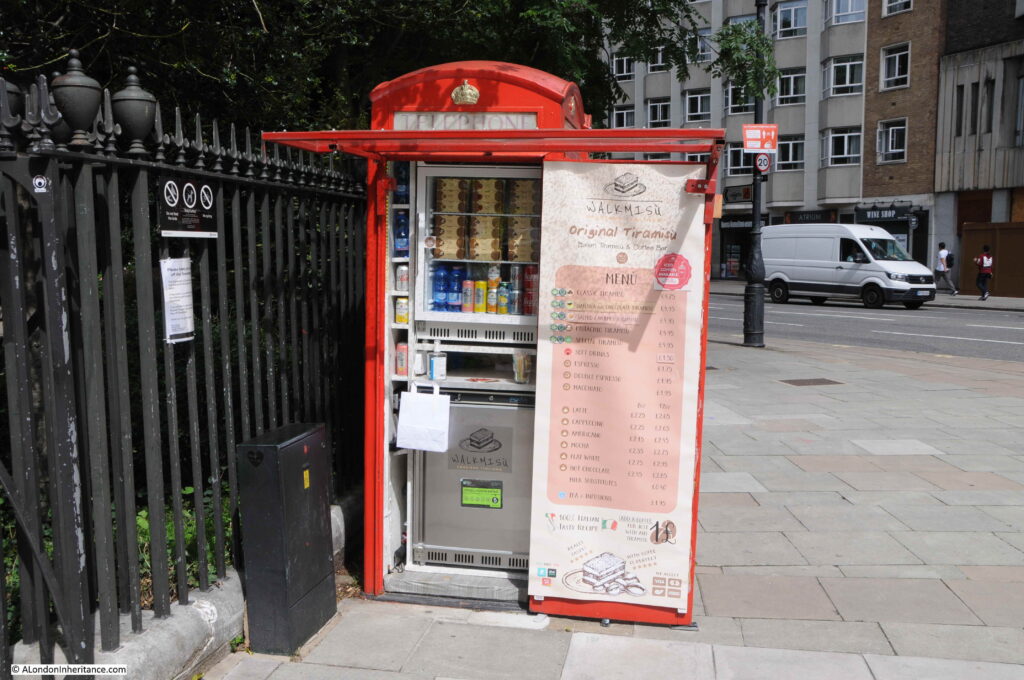
Known as the Italian Tiramisu and Coffee Shop:
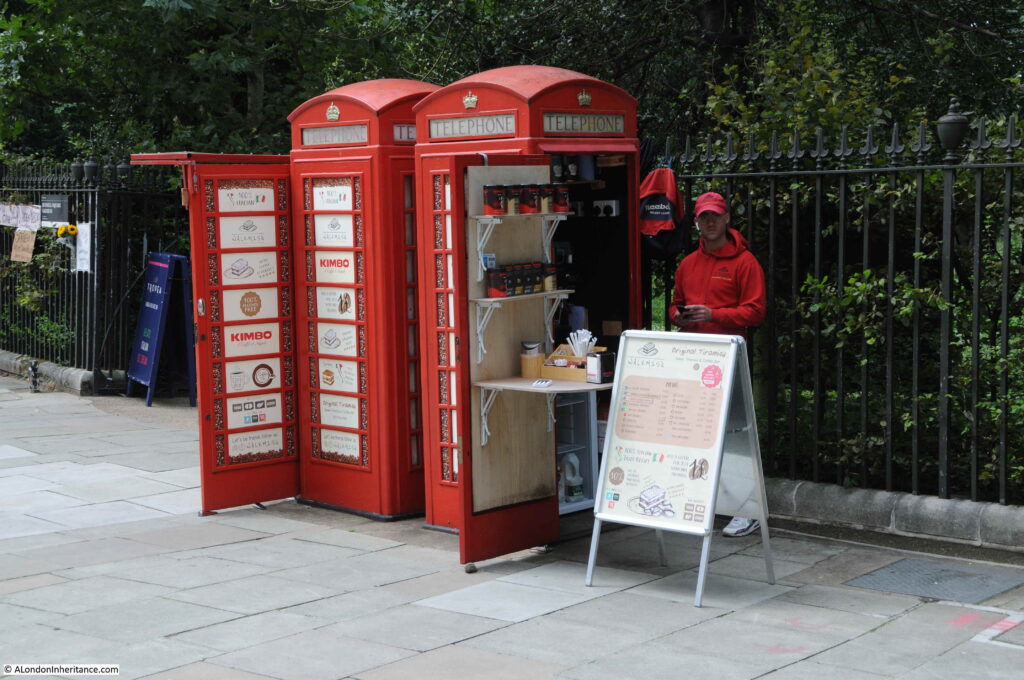
Walking further around Russell Square Gardens and there are another three, which according to the Historic England spreadsheet are Grade II listed:

At the entrance to Regent Square Gardens on Regent Square:
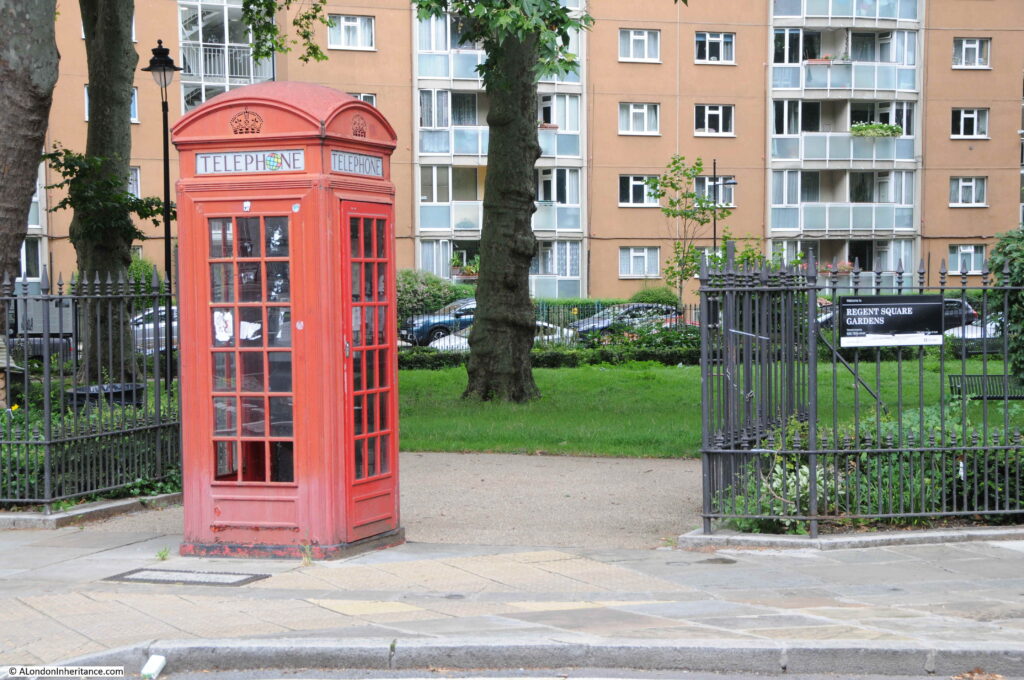
Looking inside the Regent Square Garden’s telephone box:
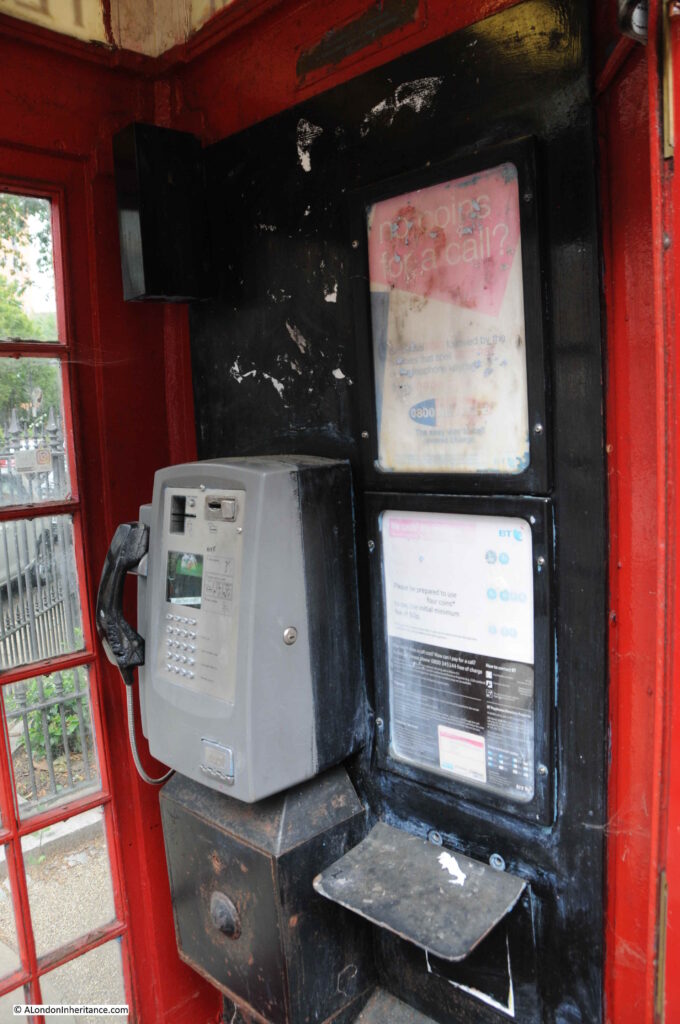
At the junction of Euston Road and North Gower Street:

Upper Street, Islington:
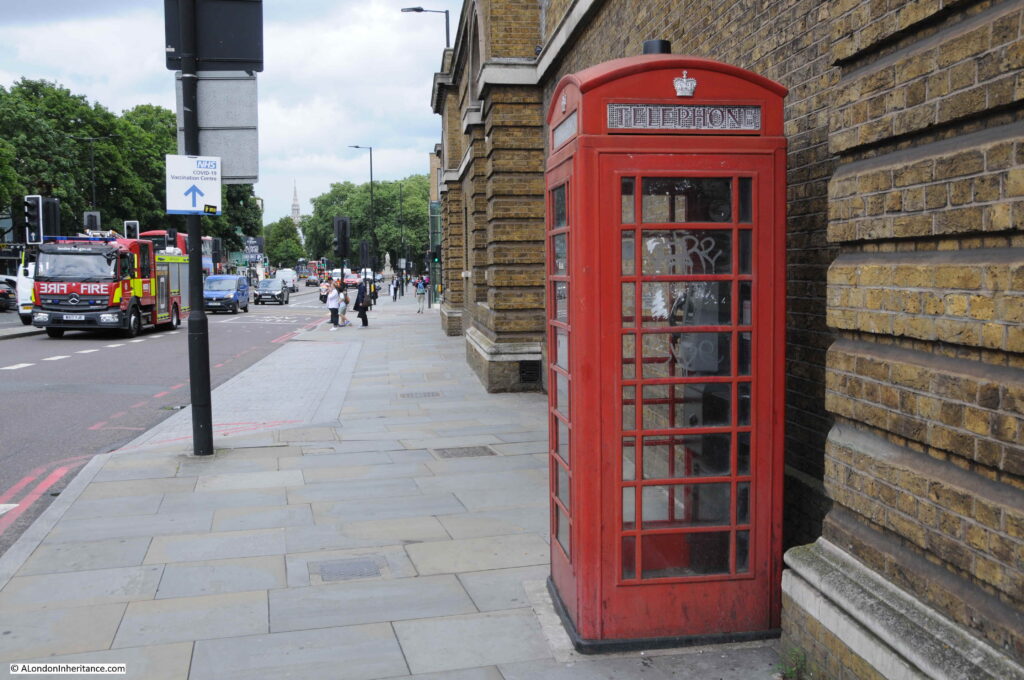
Across the road from the above phone box is the following:
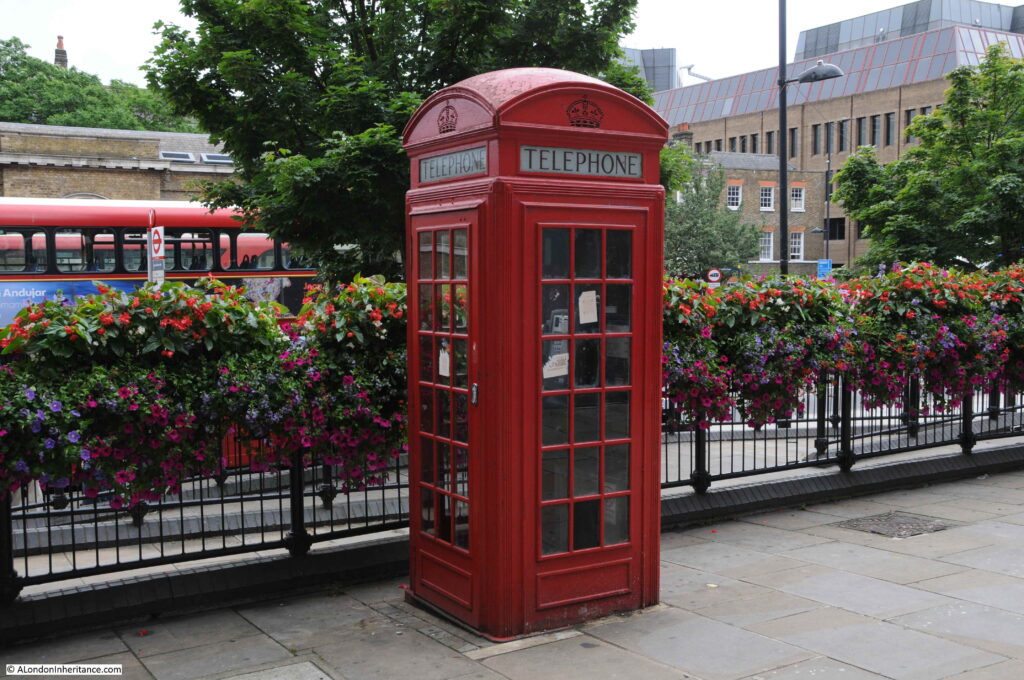
Waterloo Place, looking up towards Piccadilly Circus:

The Strand, close to Charing Cross Station:
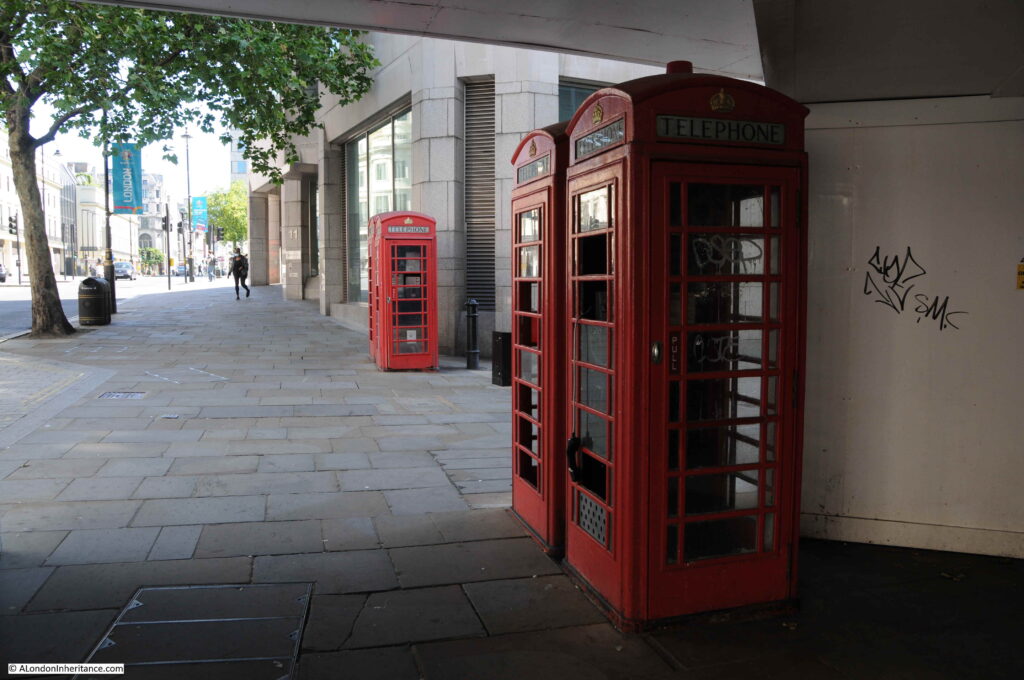
Opposite Charing Cross Station are these four telephone boxes:
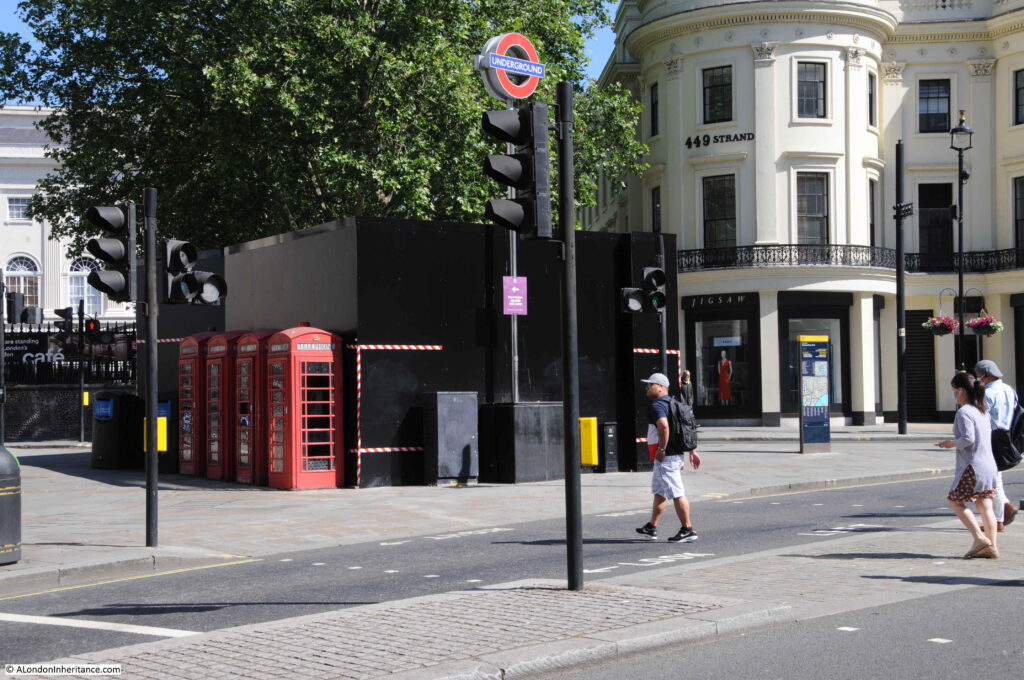
They are usually more obvious, however the black hoardings to their right are slightly obscuring them.
Hard to imagine seeing a row of four, empty telephone boxes, however they were sited together in an area of frequent use. In a high footfall area, between the Strand, Charing Cross Station, Trafalgar Square and the theatres of the West End, they would have attracted a considerable number of users.
When I commuted into and out of London during the 1980s, train distruption would always lead to long queues at the phone boxes as the only means of communicating with those at home, or who you were to meet, that you would be late.
Later conversions of telephone boxes have tried to keep them relevant, however Internet access on a mobile phone renders WiFi from a phone box a failed model for their continued use.
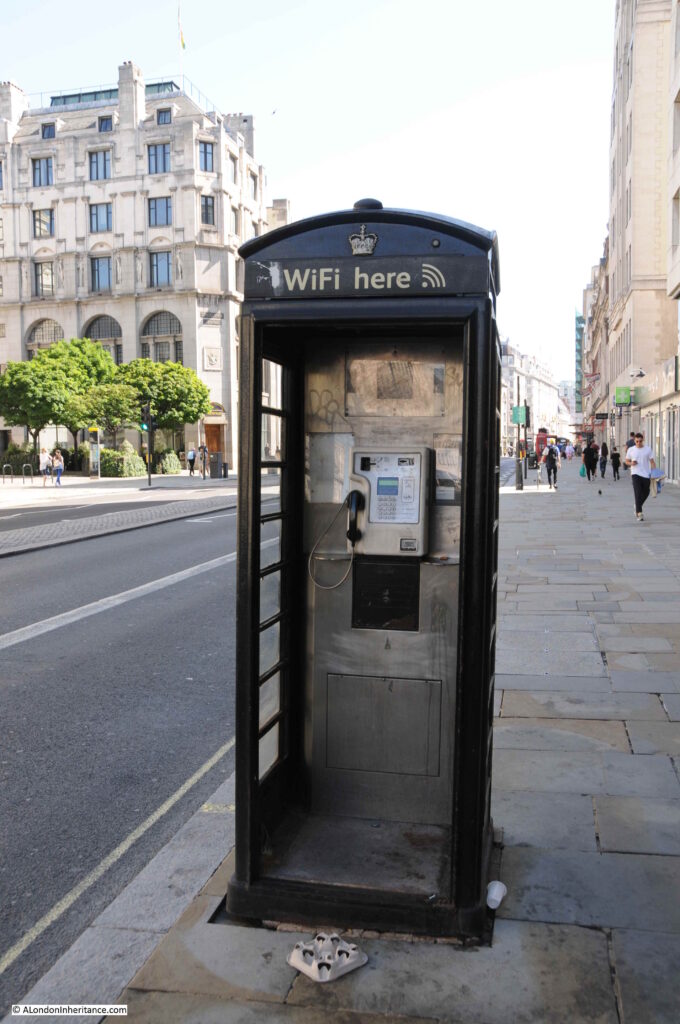
These two telephone boxes are Grade II listed, so even if there are no customers who have an urgent need to make a telephone call from in front of St Paul’s Cathedral, they will probably be here long into the future:

In the triangle of land where St Martin’s le Grand meets Cheapside:
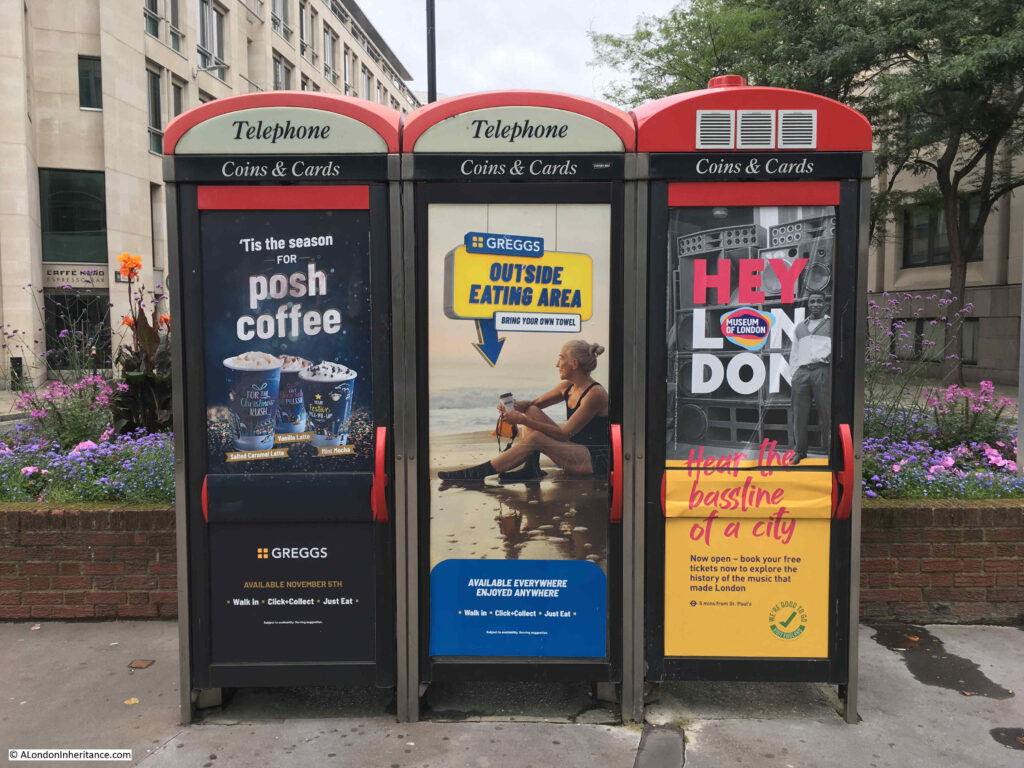
Telephone boxes advertising the time when cards as well as coins could be used to pay for a call:

Euston Road:
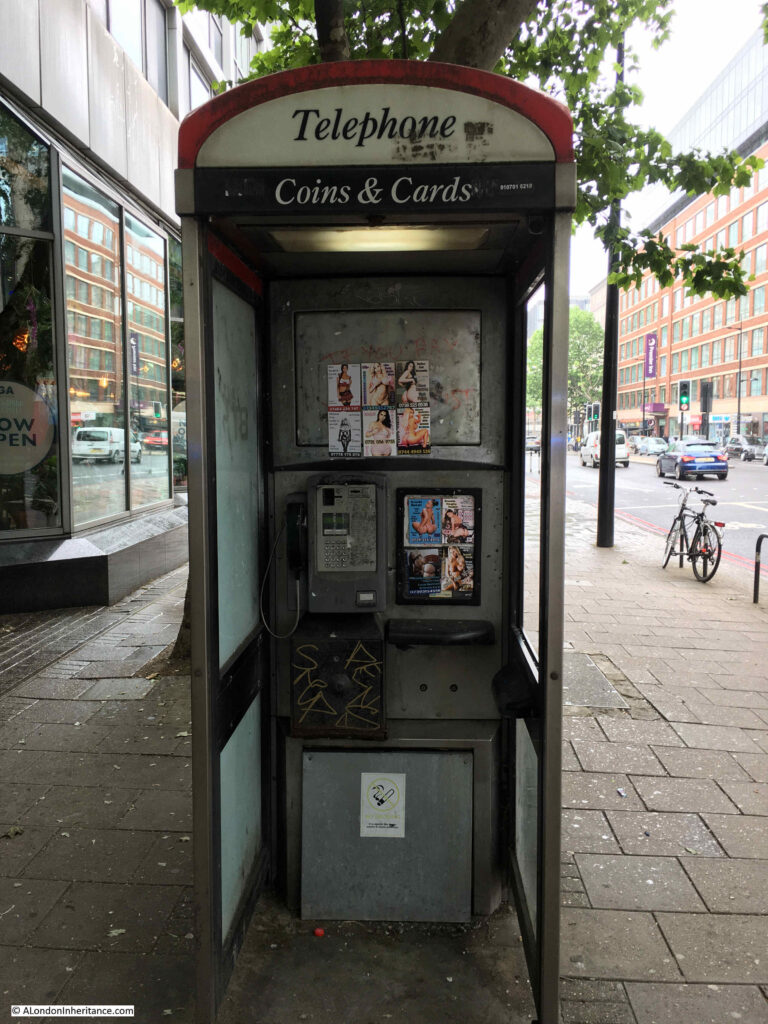
Outside St Pancras Station, with the sex work adverts that were once common across central London telephone boxes:
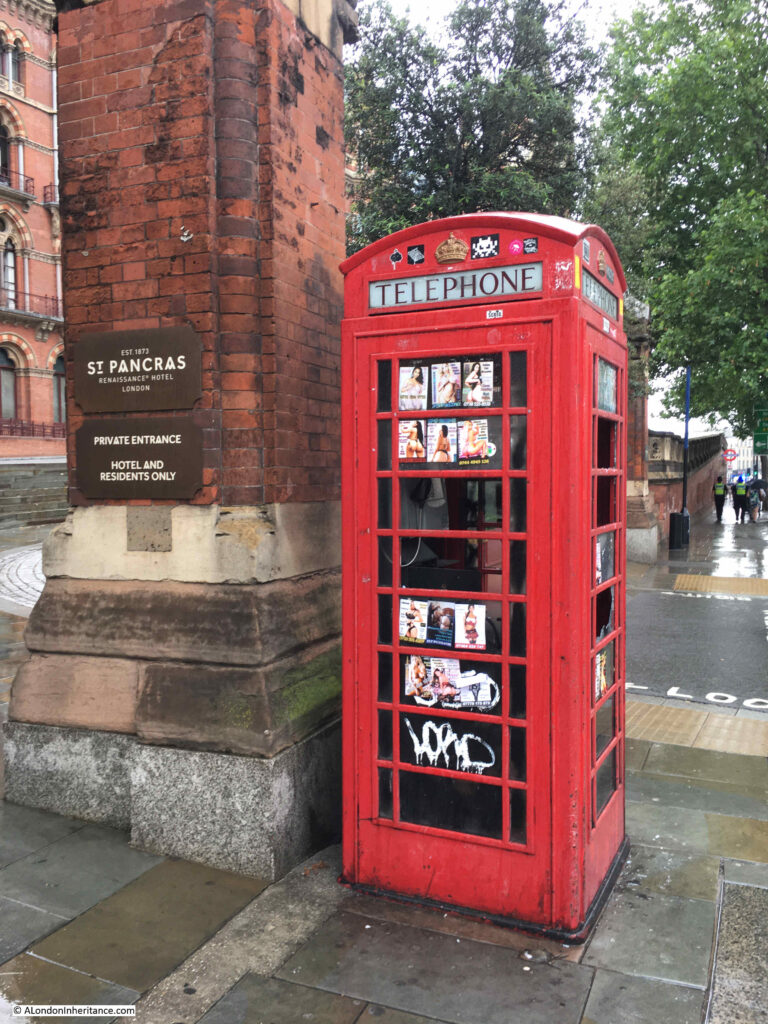
I titled this post the Death of the London Telephone Box, however that is not quite true. Many of them are listed so presumably will be around for years to come, and they are valuable assets as an advertising platform, however what they will not be used for is their original purpose of making telephone calls.
What is clear is that many are not maintained or cleaned. I have found very few that actually work. Many have had their equipment removed, others have been vandalised and many of the remainder are just dead.
I suspect the majority of people under the age of thirty have never used a telephone box, and find the concept of a fixed, wired phone rather antiquated.
They are a left over from a time when the only way to make a call when out on the streets was from a telephone box. When you needed to call for a lift home late at night, meet with friends, change an appointment, check on a place to meet, or just simply calling someone for a chat, the red telephone box was an essential part of street infrastructure.
One of my other photographic themes is information panels, intended to show the passerby what can be seen in the area. I walked by this one a couple of weeks ago, close to the Bank junction:
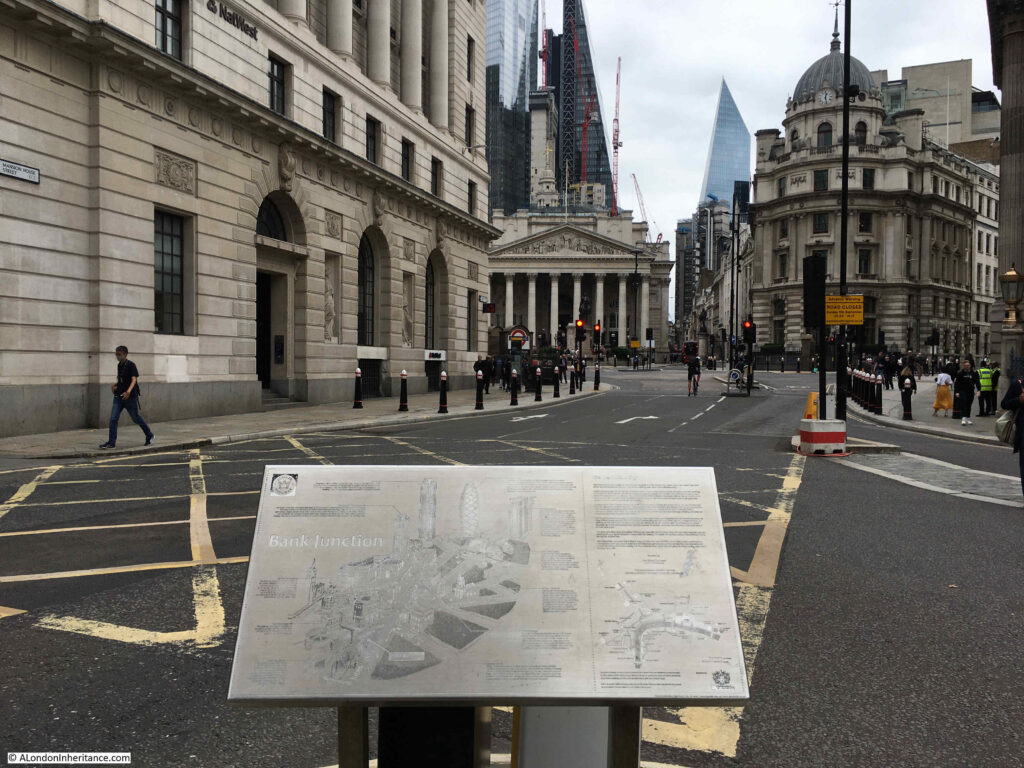
The plaque was unveiled by the Queen in October 2002, and shows the City’s skyline as it was, just 19 years ago,
Thr highlighted buildings include the London Stock Exchange, Tower 42 (the old NatWest Tower), 30 St Mary Axe (the Gherkin) and the Lloyds of London building.
it is a strange location as none of these buildings can be seen from the location of the plaque. I cannot remember if it has been moved from a different location. The “You Are Here” label on the map implies it is in its original location.
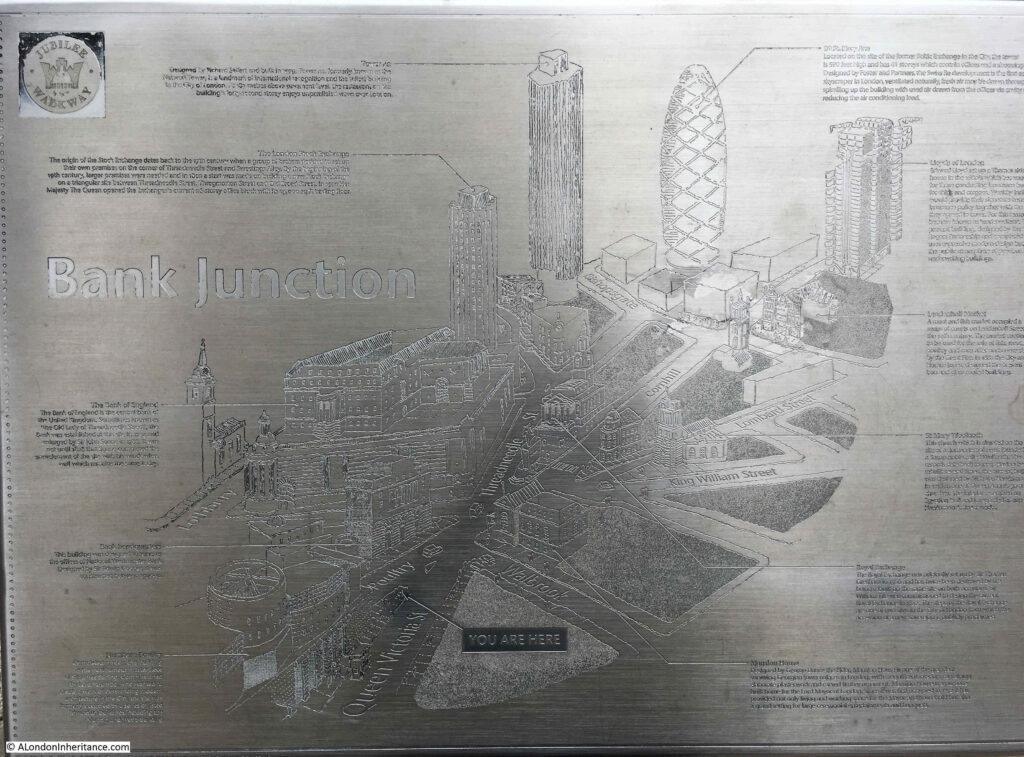
Walking further into the Bank junction and only Tower 42 remains visible, although now partly obscured.

London’s streets will continuously change, as technologies change as do the buildings lining the streets.
As with the transition from telephone boxes to mobile phones, there seems to be another transition gradually underway with the introduction of low traffic neighbourhoods, closure of many city streets to vehicles, cycle lanes etc.
It will be interesting to see how this impacts the city’s recovery from the pandemic, Does it enhance the city, or restrict its viability as a place to work.
In future, will the car in a city be seen the same as a telephone box today, an essential in the past, irrelevant in the future?

I may be wrong but I seem to remember calls costing 4d in the A and B button phones and that you had unlimited time, hence queues forming outside. Unlike the next version which cost a minimum of 5p (after decimalisation) and the dreaded pips when your time was up and the mad scramble to find another coin. I think you could put in a 50p coin too?
Decimalised AB boxes at first accepted 1P and 5P but were relatively changed to 2P and 10p. The “pips” pay-on-answer phones accepted 1d, 3d and Shillings, most later took 2p, 5P and 10p and later still 5P and 10p and at the end, 10p only. 50p wasn’t accepted in any payphone until the Blue Payphone in 1980, which took 2p (four, i.e. 8p, was the minimum charge), 10p and 50p. I have one of the original trial Blue Payphones, the CT22A, made in Switzerland in September 1980 with the LED display. it was at York railway station. The production version, the CT22B had a LCD display as were made, in much greater numbers, here in the UK.
Something that comes back to me very clearly looking at those pictures is the SMELL of the interior. I bet everyone who ever used a phone box can remember it vividly. It was unique. And then there were the two-inch-thick telephone directories held in a sort of rack like those big albums of wallpaper samples.
The state of so many of these boxes is thoroughly dystopian. It would be good if some of them could be converted for use as a point of contact for the Emergency Services, perhaps, together with a defibrillator. Though you have to wonder how long even those would last intact.
What a brilliant idea! Get it sorted, Boris!
There are quite a few that are already used for that. BT have to pay to get the electric supply disconnected, so often don’t bother. So the defibrillators have a constant free supply of electricity to charge the batteries, and in return the boxes are maintained. Even by current ‘standards’ you’d have to be pretty low to smash up a defibrillator (though i don’t doubt some people ‘achieve’ that level of… vermin?)
That’s good to know. I’ve seen some other uses in small towns and villages, too. They get turned into mini libraries, or plant swop shops. Giving them some sort of function does seem to reduce, if not completely remove, the likelihood of them being trashed.
Before D-Day (15th February 1971), a local call cost 4d. If the exchange was automatic you put the coins in the slot and dialled your number. You could hear the voice of the person you were calling when they answered but they couldn’t hear you unless you pushed Button A to make your coins fall into the cash box. If the call was unanswered, you pushed button B and your coins were expelled into the open tray at the base of the cashbox. The town I grew up in still had a manual exchange into the 1970’s so you put in your money and dialled 0 to connect with the operator. When she answered you gave the number you wanted. She connected you and told you to push button A. If your long distance call had to be connected manually the operator would interrupt your conversation to tell you to put in more money: the pips told you to put in more money when the call was connected automatically by STD. After D-Day the cost of a local call rose to 5p, equal to 12 old pennies. I stopped using the local phone box when my parents had a telephone installed at home early in 1973.
I wonder whether the cost of calls varied in different parts of the country ?
I was living in South Lancashire in the early 1970’s, and after D-Day, the two slots took 2p and 10p coins. Needless to say, you did not get very long for 2p.
No, my mistake: the cost of a call after D-Day was 2 (or 4 – I can’t remember) new pence. The rise to 5p came later.
Always worth pressing Button B if you were passing, just in case.
Surprised you didn’t mention that the original, wooden K6 prototype can be found just inside the courtyard of the Royal Academy, Piccadilly. The most photographed production ones used to be the 4 outside Bow Street Magistrates’ Court.
That’s the wooden mock-up of the K2 at the Royal Academy. It was – along with the mock-ups of the other three entries – constructed for display in the competition for designing the K1’s successor.
I think that the crown over the door was amended so that it could be slid out and, when the box was in Scotland, a Scottish crown could be inserted. One of the ‘Scottish’ boxes is outside Smithfield market.
Although a child of the 1950`s/60`s I never used a phone box as we had one at home until I lived in London in the 70`s. Even then touring round Islington area to find one that wasn`t vandalised to phone home every Sunday could be a trek !!
A great collection of images of rather sad kiosks. A couple of typos in your captioning- the mixed group of kiosks in Smithfield are K2 and K6’s, but the larger kiosks are the K2s (the ones with equal sized window panes). K6 kiosks (the ‘Jubilee’ kiosk) were introduced in 1936, with a sole prototype installed in London in December 1935. The black kiosk isn’t actually a Post Office/BT kiosk, it is a ‘looky likey’ from another company. Just to correct one comment above re the kiosk at Burlington House (Royal Academy). That is the original K2 kiosk prototype. Thanks for sharing these images, a sad testament to the current condition of many. I fear the only practical solution for these long term will be something like the (sympathetic) conversion to other uses like the coffee bar you show
I think ‘looky likey’ might be a bit unfair. New World did purchase them new for installation but I believe they were cast from original moulds, which would make them genuine K6s.
I thought I had learned from the “A London Inheritance” blog in the past that the design of the K2 was based on the tomb of Sir John Soane in St Pancras churchyard? Don’t know if I did, for sure, or even if it is true and not an urban myth….
Some great photos, as ever.
The phone companies are seeking to exploit the prominent location of old boxes to replace them with advertising stands (sorry, communications centres containing ‘illuminated digital advertisement displays’). Most London local authorities seem to have been bombarded with these applications which, mercifully, have been mainly refused, although the phone companies are persisting with lengthy appeals.
The loss of the familiar K6s will be a shame. Let’s hope local authorities continue to resist the commercial pressure to replace them with illuminated advertising eyesores.
PS Unless I missed it, you didn’t mention that Scott’s original design was based on Sir John Shane’s monument designed for his wife in the churchyard of St Pancras church (worth a photo and blog in itself).
You’re right – but David’s already done it here: https://alondoninheritance.com/london-churches/st-pancras-old-church/
Is it true the design was based on the Soane mausoleum round the back of Kings Cross? I’ve heard this story several times.
https://www.alamy.com/soane-mausoleum-in-st-pancras-gardens-inspiration-sir-giles-gilbert-image68061020.html
See David’s article here https://alondoninheritance.com/london-churches/st-pancras-old-church/
It includes that story.
Whilst I found this article interesting and the photographs of specific boxes fascination I also felt an overwhelming feeling of depression. Many of the photos truly show what we have become as a country. One where there is little respect for public property or in this case street furniture. The destruction or disfigurement of phone boxes and interiors did not, as far as I am aware take place before the 1970s? Perhaps it may never have occured to those who behave in this destructive manner, that the phone box might be a life-line between potential death or saving someones life. I know most of us carry mobile phones today, but that is not the point, a telephone box was put in place to help one person communicate with another. it is not ‘yours to destroy or damage’. Also I felt red was the best colour for a box to be seen at a considerable distance, and so in this respect, so much better than later versions.
I felt just the same.
When the K6 was first introduced, may rural councils felt the red colour ‘too garish’ and official blessing was given for rural kiosks to be painted in more sombre colours- grey, green etc., however glazing bars were supposed to always remain red. I still come across the more muted colouration on occasion.Daft isn’t it. We now look on it as a classic colour, not only that but I can imagine what a relief it would be to have seen the reassuring red painted kiosk from afar if broken down or in need of a call home, pre-mobile phone of course. There again, there remain just a few pockets of our coutryside with little in the way of reception and the local kiosk continues to provide an essential service
Some of my less reputable peers used to stuff paper up the hole where the pennies would drop after button B was pressed. They would go back later, pull the paper out and scoop their ill-gotten gains. High tech crime!
Where I live now, in the South Pennines, four of the phone boxes have been used as defibrillators as suggested. There have been no issues of vandalism but that is probably because of the oversight of locals who have even been known to paint the boxes (in the correct colour of course).
I heard the story, possibly apocryphal, told my my family in Hull, that a national company developing films apologised because the phone box in the photo didn’t come out in the correct colour – red. That might have been because the phone boxes in that city were always cream-coloured because they were provided by a separate company.
Enough phone box ephemera! Thank you for another enjoyable post.
As an American, working in London in the 1960s, I occasionally would get a call at home with no one on the other end. Another U. S. Visitor announcing his arrival! PUSH BUTTON A !!
I, too, remember that unforgettable smell of the telephone box — the combination of cigarette smoke and dry-cleaning fluid that was a permanent feature of so much clothing then, plus whatever disinfectant was used to clean the interior of the phone-box and its equipment. How frequently were they cleaned, I wonder? Covid has taught us just how lethal these small spaces and the telephone itself can be but did anyone ever think then about the likelihood of picking up a cold or flu from the germs left by the last person to speak into the mouthpiece? Our mothers (mine anyway) warned about the dangers of public toilet seats (!!) but I don’t recall being warned about public phone boxes.
Unbelievably, part of the design brief for the instalation of telephone kiosks was that the concrete plinth would incline toward the door, even then it was recognised that they would be used as public urinals!
Or maybe people would use them as shelter in the middle of a rain storm when already drenched?
Fascinating post! Thanks.
Fascinating and, as usual, brilliantly researched. Thanks. There are four boxes tucked away behind the Royal Courts of Justice in Carey Street. I’ve never seen anyone use them but in their day must have been the conduit for so much good & bad, sad & happy news. https://www.google.com/maps/@51.5150045,-0.1129726,3a,80.4y,168.87h,98.53t/data=!3m6!1e1!3m4!1s6jI5U3zFJkae820CqrKdTA!2e0!7i16384!8i8192
For those who enjoy an unsolved mystery, the 1952 film The Happy Family includes a street scene where a young looking George Cole accompanies his screen fiancée (Eileen Moore) to a public telephone box. The weight of the door and the concrete plinth suggest it was a genuine telephone box rather than a film prop. But where was it?
Many of the film’s location shots give unique views of the Vauxhall and Nine Elms areas as they looked in 1951 / 52. That might give a clue to the phone box’s location. But it might not!
The telephone box scene is depicted here:
https://www.reelstreets.com/films/happy-family-the/
Pimlico Pete
65,000 calls a day are made through BT’s boxes, this doesn’t include the black New World kiosks. The phones to be retained 9 out of 10 work in response to your comment about most don’t work.
Freephone 0800/0808 calls generate 70p per minute for payphones, this charge is billed to the owner of the freephone number. This also applies to mobile networks but they only get 2p per minute.
Calls to 101 police is actually completely free to call unlike from home phones and mobiles.
Most BT phoneboxes are now being used for small 4G/5G masts supporting mobile network coverage.
If you find a damaged phone or a dirty please report them customer.serv.payphones@bt.com 0800661610
If they are New World kiosks, there will be contact details in the kiosk.
Calls to 101 are free from mobiles and landlines since April 2020. https://www.gov.uk/government/news/general-public-should-not-have-to-pay-for-101-non-emergency-calls-from-tomorrow
BT have reported back in 2017 that 33,000 calls a day were made through their boxes- I’d wager it is much less today.
We have one in our street in south London . BT tried to take it away but there was uproar and they brought it back . It’s sealed up as It was being misused . Far better just as a nice box
My last memory of using a phone box is a rather sombre one. By 2005, a good proportion of the population had mobile phones and presumably the use of phone boxes was already dropping. But on the 7th July when the 7/7 suicide bombers struck on the tubes and a bus, all the mobile phone networks went down because of the surge in demand. I remember locating one of the few remaining working phone boxes in Camden and joining the long queue to use it. I’m trusting that networks today would be able to cope with a similar demand.
Some places such as the City of Bath have successfully turned them into flower boxes and they are a wonderful addition to the streetscape
Great Post again. Good to see that one of the photos was of a box I used frequently in the 60s &70s, I.e the one on the embankment with Battersea Power Station in the background. We had a landline nstalled in our Pimlico home in 1967, so I used that box fir conversations I didn’t want my parents to overhear! We lived only 50 yards from that box, which couldn’t be seen from home.
I have recently considered buying a ‘phone kiosk for the back garden, but they are quite expensive :-
https://www.unicornrestorations.com/
The sequel to this blog must be postboxes ! Another fascinating topic :-
http://www.oxfordhistory.org.uk/streets/post_boxes/victorian/wall_boxes.html
http://www.oxfordhistory.org.uk/streets/post_boxes/victorian/index.html
You can find an iconic phone box with an iconic red post box in St Katherine’s dock near the Dickens Inn. Apparently one of the few places in London you can photograph them both together.
As always a great read, Thank you.
I am surprised no one mentioned the exploding phone boxes. Gas leaked under the pavement and up the conduit in the phone box. Someone made a call, lit a fag and whoomph! It was sorted when ventilation was put in the top of the phone box
There were one or two phone boxes in the Greater Manchester area that were blown up deliberately using the explosives from industrial fireworks. They could be bought direct from a well-known fireworks company near Huddersfield. It is some years ago now and I think the laws have been tightened up. But one isolated phone box on a moorland road was distributed across the A62 in the blast. It wasn’t replaced.
Oh, thank you. I have walked past many of these. I recognize the top of The Coliseum in your photo of St Martin’s Lane!
I have a few photos of public phones in Hawaii, which are particularly charming.
https://photos.app.goo.gl/gW5aX39B7UjNWqnMA
A fine post, as usual.
How many tourists to London have taken away a model or an image of the red telephone box? Now it’s so sad to see them in this sorry state.
My memories phone boxes are very fond. I was born in London in 1942 and we had no telephone at home. If we needed to make a call then it was a walk to Manor House tube station and use one of the kiosks.
The price of a call from memory was 2d (2 old pence – about 1p) for three minutes – in 1959 it went up to 4d.
Useful was the pile of thick alphabetic directories – later replaced with the directories in hinged boxes.
First make sure you have the right coins ready. Pick up the heavy handset, put your two pennies in the slot which made a pleasant ‘ching’ – then dial the number. When the number answers press button ‘A’ and you got through. If there was no answer you pressed button ‘B’ to get your coins returned.
There’s a good description here:
https://www.1900s.org.uk/1940s50s-public-phones.htm
As a young apprentice I spent many a happy lunch break half-hour in the phone box (which still stands outside Saddler’s Wells Theatre) talking to my girl friend Kay – if I ran out of money she would phone me back.
Happy memoriesw.
It is unsurprising that you did not feature a K3. AFAIK, the only surviving K3 in London is in London Zoo. No doubt it is well fed and cared for, but is not accessable for free.
I spent some time in a guided walk last year showing someone how to distinguish a K2 from a K6. Then she saw this one, so I gave up.
https://goo.gl/maps/EJKassdfVrdguRJB9
Link to La Cabina is broken
Thanks for letting me know. Will see if I can correct with a new link.
I love how this blog post captures the nostalgia of London’s telephone boxes. I grew up in London and always loved going to the phone boxes to call my family back home. They’re such a part of London’s history and I’m glad
There was a green telephone box in London, somewhere between Charing Cross station and the Embankment I think. In the Lake District, the boxes were grey to match the slate. Yes, I used telephone boxes for conversations I did not want my parents to overhear, most notably to discuss with a friend how to stop my mother going to see my sixth-form tutor about my progress – my life was my own by that stage I thought. In John Rowe Townsend’s children’s novel ‘Gumble’s Yard’ (1961) the narrator makes a call from a railway station. When it is answered: ‘I pressed button A.’ In a later revised edition this sentence is deleted just as, when something his interlocutor says is drowned out by the sound of a train letting off steam, this was later altered to a train arriving.